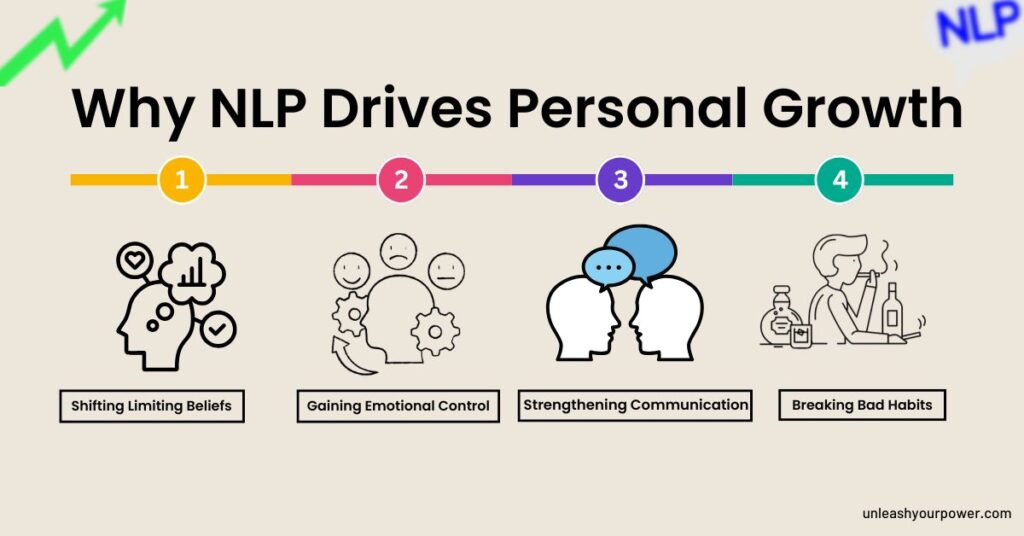Negative thoughts creep into everyone’s mind at some point. Maybe you’ve heard that voice in your head saying, “You’re not good enough” or “What if everything goes wrong?” You’re not alone. Studies reveal that 80% of our daily thoughts are negative, and many of us wrestle with breaking this pattern.
But what if you could change it? Neuro-Linguistic Programming (NLP) offers practical tools to help you shift your mindset, stop negative thoughts in their tracks, and make lasting, positive changes.
In this article, we’ll break down NLP for Overcoming Negative Thought Patterns, introduce techniques like anchoring and reframing, and guide you through a simple exercise to flip the script on self-doubt and overthinking. Whether you’re looking to silence that inner critic or boost your mental clarity, NLP can help you regain control of your thoughts and embrace a more positive, productive version of yourself.
What Are Negative Thought Patterns?

Negative thought patterns are automatic, unhelpful ways of thinking that trap you in cycles of self-criticism, fear, or doubt. They often become ingrained, shaping how we see ourselves and the world. Think of them like a mental rut, one that’s tough to break free from.
For example, self-doubt makes you second-guess your abilities, even when there’s no reason to. Your mind asks, “What if I’m not good enough?” Catastrophizing leads you to jump to worst-case scenarios. Spill coffee on your shirt?
Suddenly, your entire day is “ruined.” Imposter syndrome convinces you that you’re just pretending to be competent, and sooner or later, everyone will figure it out.
These patterns don’t just weigh on your mood. They can hold you back in life, making it hard to take risks, limiting your growth, and damaging relationships. Over time, they may even affect your mental health, leading to stress, anxiety, or depression.
But here’s the silver lining: negative thought patterns can be rewired. With NLP techniques, you can spot these thoughts and replace them with more helpful ones.
How NLP Rewires the Brain
NLP works by reprogramming your brain, much like resetting a GPS route. Imagine your brain as a network of pathways. Negative thinking wears these pathways down, forming deep mental grooves, much like well-trodden dirt roads. The more you use them, the more stuck they become.
NLP steps in by building new, healthier mental roads. The brain’s ability to reshape itself—known as neuroplasticity—is key here. Just as repetitive exercise strengthens muscles, practicing positive thinking rewires the brain, forming fresh patterns.
Take John, for instance. He felt crippled by anxiety before public speaking. Through NLP’s anchoring technique, he learned to link feelings of calm and confidence to a simple gesture—squeezing his thumb and finger together. Over time, this small action became his trigger for calmness, helping him speak in public without nerves.
NLP doesn’t offer a quick fix; it provides lasting change by teaching your brain to react differently to challenges.
Why NLP Drives Personal Growth

Imagine having a switch that lets you control how you react to life’s challenges. NLP gives you that power. Whether you’re breaking limiting beliefs, boosting communication skills, or building better habits, NLP is a catalyst for personal and professional growth.
Shifting Limiting Beliefs
Those sneaky thoughts—“I’m not good enough” or “I’ll never succeed”—can quietly sabotage progress. NLP helps you flip the mental script, turning “I can’t” into “I’m learning.” This small shift unlocks new opportunities, helping you break free from chains of self-doubt.
Gaining Emotional Control
Ever felt anxiety take over? NLP helps you regain the wheel. Techniques like anchoring enable you to trigger positive emotions when needed. Think of a sports player visualizing past victories before a game—NLP equips you with similar tools to stay calm and focused under pressure.
Strengthening Communication
Our growth often hinges on how we connect with others. NLP sharpens your ability to respond, listen, and build trust, paving the way for deeper personal and professional relationships.
Breaking Bad Habits
NLP offers practical solutions for kicking habits that no longer serve you. Techniques like the Swish Pattern allow you to replace old routines with healthier, more productive behaviors.
Getting Started with NLP
Neuro-Linguistic Programming isn’t just theory—it’s a toolbox. Here’s how to start using NLP to improve your thinking, behavior, and growth:
- Set Clear Goals: Don’t just aim to “improve.” Be specific. “I will read 10 pages a night” sets a clear path and keeps you motivated.
- Change Your Inner Dialogue: Your self-talk matters. Replace “I’ll never get this right” with “I’m improving every time I try.” This simple shift builds confidence.
- Anchor Positive Emotions: Find a small action—like tapping your fingers—that you can link to a confident memory. The next time you need that feeling, use the action to trigger it.
- Break Bad Habits: NLP’s Swish Technique helps replace negative habits with positive ones. Picture the bad habit, then visualize the new, desired behavior. Practice this mental switch until it becomes second nature.
- Reframe Challenges: Instead of thinking, “I failed,” ask, “What did I learn?” This flips problems into opportunities for growth.
- Visualize Success: Spend a few minutes each day picturing your goals achieved. Visualization helps keep your brain focused and motivated.
Practice these techniques daily, and you’ll notice real shifts in how you think and feel.
NLP for Overcoming Negative Thoughts Pattern
Negative thoughts can keep you stuck, but NLP (Neuro-Linguistic Programming) gives you simple tools to turn them around. Here’s how you can start using NLP techniques to take control of your thoughts and stop negativity from holding you back.

- Reframe: When a negative thought appears, ask, “How can I see this differently?” Shifting your perspective reduces the thought’s power over you.
- Swish Technique: Replace negative thoughts with positive ones by mentally switching from the negative image to a positive one. Repetition will train your brain to favor the better option.
- Anchor Emotions: Link positive feelings to a small physical action. When negativity strikes, use the action to quickly bring back the positive emotion.
- Interrupt Patterns: When negative thoughts start, do something unexpected, like standing up or clapping. This interrupts the thought cycle and snaps you out of the loop.
- Change Your Inner Dialogue: Speak kindly to yourself. Replace harsh self-talk with encouraging words that push you forward.
- Dissociate from Emotions: Visualize yourself as an outsider watching your emotions. This distance helps you see the situation clearly, without getting overwhelmed.
- Challenge Beliefs: Ask yourself, “Is this really true?” Challenge the negative beliefs and replace them with more empowering ones.
FAQs
How does NLP differ from traditional therapy techniques?
Unlike traditional therapy, which often focuses on understanding the root of emotional issues, NLP is action-oriented. It provides practical tools to quickly reframe thoughts and change behaviors. NLP is about focusing on solutions rather than dwelling on problems.
Can NLP techniques be used in daily life outside of overcoming negative thoughts?
Absolutely! NLP techniques can be applied to various aspects of daily life, such as improving communication, setting clear goals, managing stress, and building better relationships. The flexibility of NLP allows you to adapt its principles to almost any personal or professional scenario.
Is NLP effective for managing stress and anxiety?
Yes, NLP can be highly effective for managing stress and anxiety. Techniques like dissociation help create emotional distance from stressful situations, while reframing helps shift your perspective on anxiety-inducing events, allowing you to approach them with more clarity and calm.
Can NLP improve my confidence and self-esteem?
NLP is a great tool for boosting confidence and self-esteem. By replacing negative self-talk and limiting beliefs with empowering thoughts, NLP helps you build a more positive self-image and trust in your abilities. Anchoring positive emotions to specific actions also reinforces feelings of confidence.
How quickly can I see results from using NLP techniques?
Results from NLP can vary depending on the individual and the techniques used. Some people may notice changes immediately, especially with techniques like anchoring or reframing, while others may need consistent practice over time to rewire deeper thought patterns. Regular use of NLP tools often leads to faster, more lasting results.
Conclusion: Making NLP a Lifelong Tool
NLP isn’t just about stopping negative thoughts—it’s a lifelong tool for growth. The more you practice, the stronger your mental muscles become. Each day offers new opportunities to break limiting patterns and build healthier ones.
The best part? NLP grows with you. Whether you’re managing everyday stress or aiming for big goals, NLP keeps you in control of your mindset and actions.
Make NLP part of your daily routine, and watch how it transforms not only your thinking but also your life.





